MBA 609 - Relationship Marketing and Consumer Loyalty Analysis
VerifiedAdded on 2023/06/15
|7
|1922
|478
Essay
AI Summary
This essay explores the impact of relationship marketing on consumer loyalty, particularly within the Indian automobile industry. It highlights the increasing competition due to LPG (Liberalization, Privatization, and Globalization) and the shift towards customer-driven marketing. The research methodology employs exploratory and casual research to understand customer loyalty. Key findings emphasize the importance of customer centricity, commitment, trust, and communication as essential factors in relationship marketing. The analysis uses exploratory factor analysis and multiple regression to evaluate the relationship between relationship marketing and customer loyalty, concluding that customer centricity is paramount for retaining customers and fostering long-term relationships within the automobile sector. The study also includes scale development, sampling methods, and data collection techniques to support its conclusions.
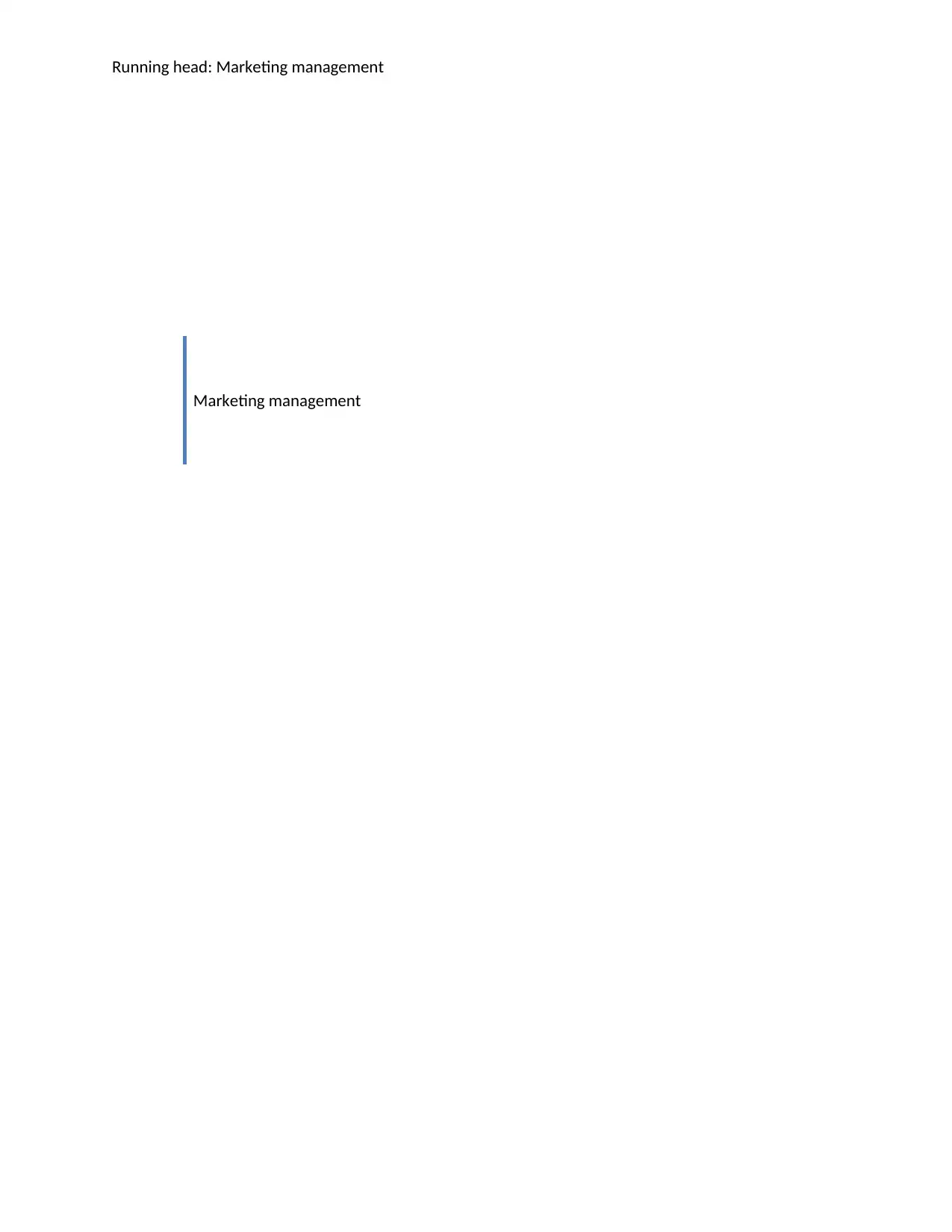
Running head: Marketing management
Marketing management
Marketing management
Paraphrase This Document
Need a fresh take? Get an instant paraphrase of this document with our AI Paraphraser
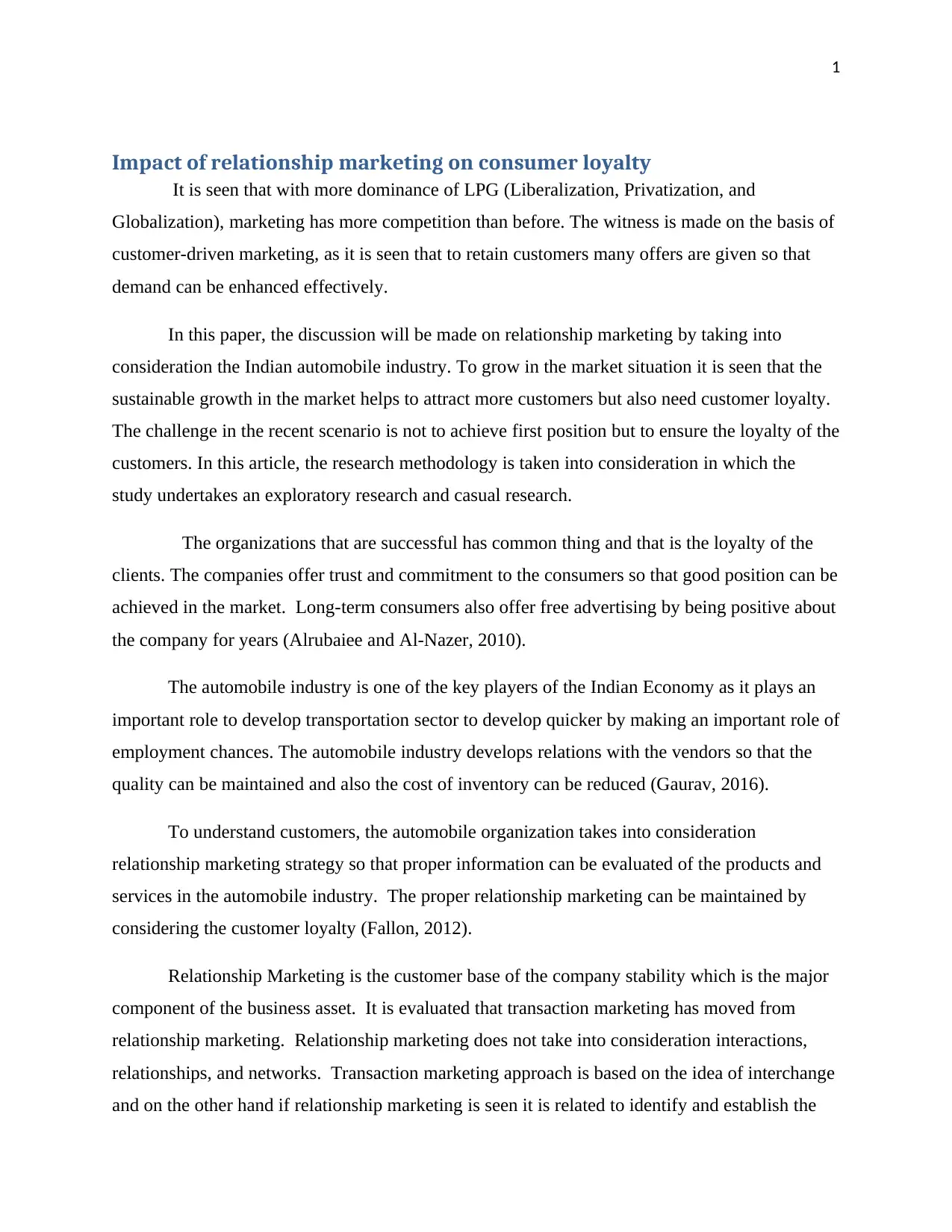
1
Impact of relationship marketing on consumer loyalty
It is seen that with more dominance of LPG (Liberalization, Privatization, and
Globalization), marketing has more competition than before. The witness is made on the basis of
customer-driven marketing, as it is seen that to retain customers many offers are given so that
demand can be enhanced effectively.
In this paper, the discussion will be made on relationship marketing by taking into
consideration the Indian automobile industry. To grow in the market situation it is seen that the
sustainable growth in the market helps to attract more customers but also need customer loyalty.
The challenge in the recent scenario is not to achieve first position but to ensure the loyalty of the
customers. In this article, the research methodology is taken into consideration in which the
study undertakes an exploratory research and casual research.
The organizations that are successful has common thing and that is the loyalty of the
clients. The companies offer trust and commitment to the consumers so that good position can be
achieved in the market. Long-term consumers also offer free advertising by being positive about
the company for years (Alrubaiee and Al-Nazer, 2010).
The automobile industry is one of the key players of the Indian Economy as it plays an
important role to develop transportation sector to develop quicker by making an important role of
employment chances. The automobile industry develops relations with the vendors so that the
quality can be maintained and also the cost of inventory can be reduced (Gaurav, 2016).
To understand customers, the automobile organization takes into consideration
relationship marketing strategy so that proper information can be evaluated of the products and
services in the automobile industry. The proper relationship marketing can be maintained by
considering the customer loyalty (Fallon, 2012).
Relationship Marketing is the customer base of the company stability which is the major
component of the business asset. It is evaluated that transaction marketing has moved from
relationship marketing. Relationship marketing does not take into consideration interactions,
relationships, and networks. Transaction marketing approach is based on the idea of interchange
and on the other hand if relationship marketing is seen it is related to identify and establish the
Impact of relationship marketing on consumer loyalty
It is seen that with more dominance of LPG (Liberalization, Privatization, and
Globalization), marketing has more competition than before. The witness is made on the basis of
customer-driven marketing, as it is seen that to retain customers many offers are given so that
demand can be enhanced effectively.
In this paper, the discussion will be made on relationship marketing by taking into
consideration the Indian automobile industry. To grow in the market situation it is seen that the
sustainable growth in the market helps to attract more customers but also need customer loyalty.
The challenge in the recent scenario is not to achieve first position but to ensure the loyalty of the
customers. In this article, the research methodology is taken into consideration in which the
study undertakes an exploratory research and casual research.
The organizations that are successful has common thing and that is the loyalty of the
clients. The companies offer trust and commitment to the consumers so that good position can be
achieved in the market. Long-term consumers also offer free advertising by being positive about
the company for years (Alrubaiee and Al-Nazer, 2010).
The automobile industry is one of the key players of the Indian Economy as it plays an
important role to develop transportation sector to develop quicker by making an important role of
employment chances. The automobile industry develops relations with the vendors so that the
quality can be maintained and also the cost of inventory can be reduced (Gaurav, 2016).
To understand customers, the automobile organization takes into consideration
relationship marketing strategy so that proper information can be evaluated of the products and
services in the automobile industry. The proper relationship marketing can be maintained by
considering the customer loyalty (Fallon, 2012).
Relationship Marketing is the customer base of the company stability which is the major
component of the business asset. It is evaluated that transaction marketing has moved from
relationship marketing. Relationship marketing does not take into consideration interactions,
relationships, and networks. Transaction marketing approach is based on the idea of interchange
and on the other hand if relationship marketing is seen it is related to identify and establish the
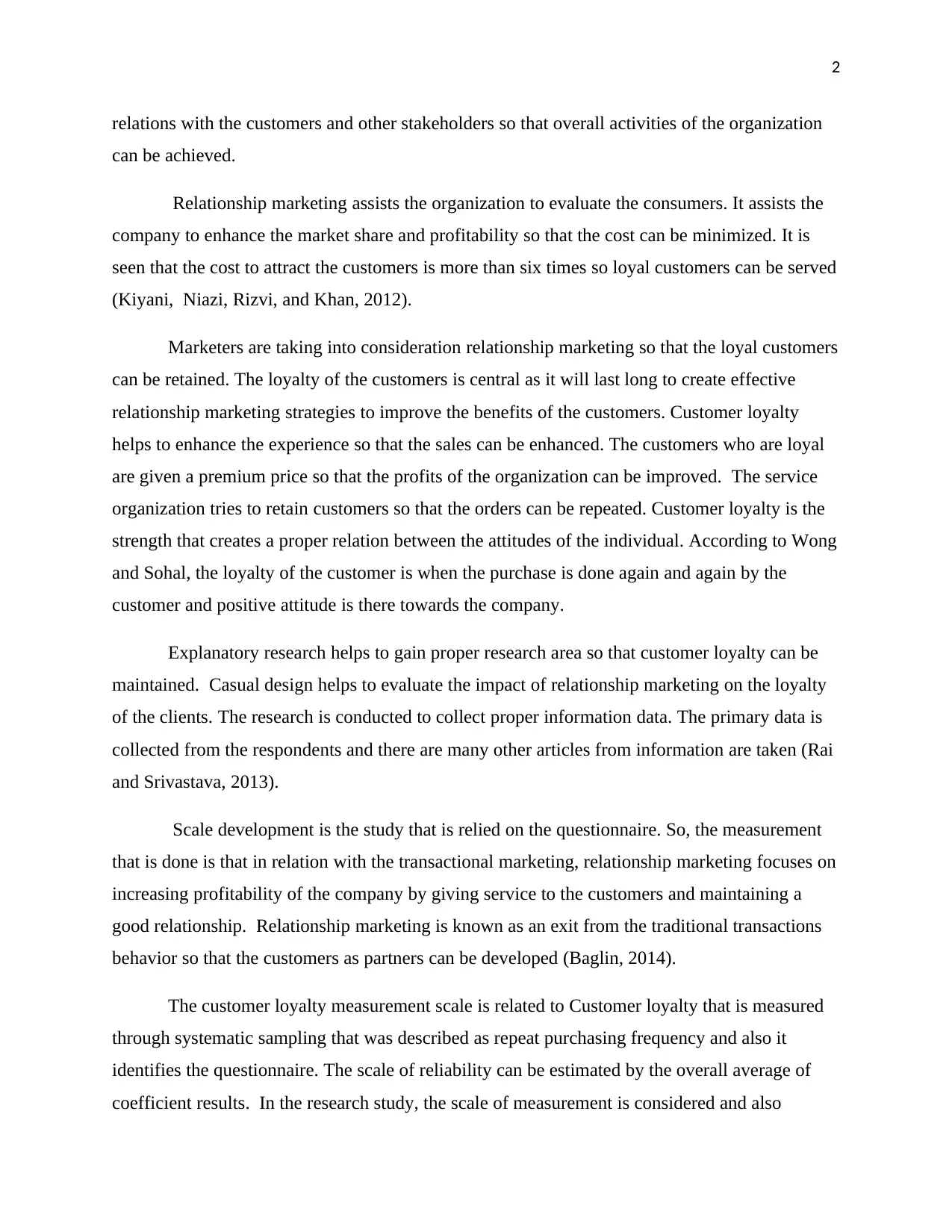
2
relations with the customers and other stakeholders so that overall activities of the organization
can be achieved.
Relationship marketing assists the organization to evaluate the consumers. It assists the
company to enhance the market share and profitability so that the cost can be minimized. It is
seen that the cost to attract the customers is more than six times so loyal customers can be served
(Kiyani, Niazi, Rizvi, and Khan, 2012).
Marketers are taking into consideration relationship marketing so that the loyal customers
can be retained. The loyalty of the customers is central as it will last long to create effective
relationship marketing strategies to improve the benefits of the customers. Customer loyalty
helps to enhance the experience so that the sales can be enhanced. The customers who are loyal
are given a premium price so that the profits of the organization can be improved. The service
organization tries to retain customers so that the orders can be repeated. Customer loyalty is the
strength that creates a proper relation between the attitudes of the individual. According to Wong
and Sohal, the loyalty of the customer is when the purchase is done again and again by the
customer and positive attitude is there towards the company.
Explanatory research helps to gain proper research area so that customer loyalty can be
maintained. Casual design helps to evaluate the impact of relationship marketing on the loyalty
of the clients. The research is conducted to collect proper information data. The primary data is
collected from the respondents and there are many other articles from information are taken (Rai
and Srivastava, 2013).
Scale development is the study that is relied on the questionnaire. So, the measurement
that is done is that in relation with the transactional marketing, relationship marketing focuses on
increasing profitability of the company by giving service to the customers and maintaining a
good relationship. Relationship marketing is known as an exit from the traditional transactions
behavior so that the customers as partners can be developed (Baglin, 2014).
The customer loyalty measurement scale is related to Customer loyalty that is measured
through systematic sampling that was described as repeat purchasing frequency and also it
identifies the questionnaire. The scale of reliability can be estimated by the overall average of
coefficient results. In the research study, the scale of measurement is considered and also
relations with the customers and other stakeholders so that overall activities of the organization
can be achieved.
Relationship marketing assists the organization to evaluate the consumers. It assists the
company to enhance the market share and profitability so that the cost can be minimized. It is
seen that the cost to attract the customers is more than six times so loyal customers can be served
(Kiyani, Niazi, Rizvi, and Khan, 2012).
Marketers are taking into consideration relationship marketing so that the loyal customers
can be retained. The loyalty of the customers is central as it will last long to create effective
relationship marketing strategies to improve the benefits of the customers. Customer loyalty
helps to enhance the experience so that the sales can be enhanced. The customers who are loyal
are given a premium price so that the profits of the organization can be improved. The service
organization tries to retain customers so that the orders can be repeated. Customer loyalty is the
strength that creates a proper relation between the attitudes of the individual. According to Wong
and Sohal, the loyalty of the customer is when the purchase is done again and again by the
customer and positive attitude is there towards the company.
Explanatory research helps to gain proper research area so that customer loyalty can be
maintained. Casual design helps to evaluate the impact of relationship marketing on the loyalty
of the clients. The research is conducted to collect proper information data. The primary data is
collected from the respondents and there are many other articles from information are taken (Rai
and Srivastava, 2013).
Scale development is the study that is relied on the questionnaire. So, the measurement
that is done is that in relation with the transactional marketing, relationship marketing focuses on
increasing profitability of the company by giving service to the customers and maintaining a
good relationship. Relationship marketing is known as an exit from the traditional transactions
behavior so that the customers as partners can be developed (Baglin, 2014).
The customer loyalty measurement scale is related to Customer loyalty that is measured
through systematic sampling that was described as repeat purchasing frequency and also it
identifies the questionnaire. The scale of reliability can be estimated by the overall average of
coefficient results. In the research study, the scale of measurement is considered and also
⊘ This is a preview!⊘
Do you want full access?
Subscribe today to unlock all pages.

Trusted by 1+ million students worldwide
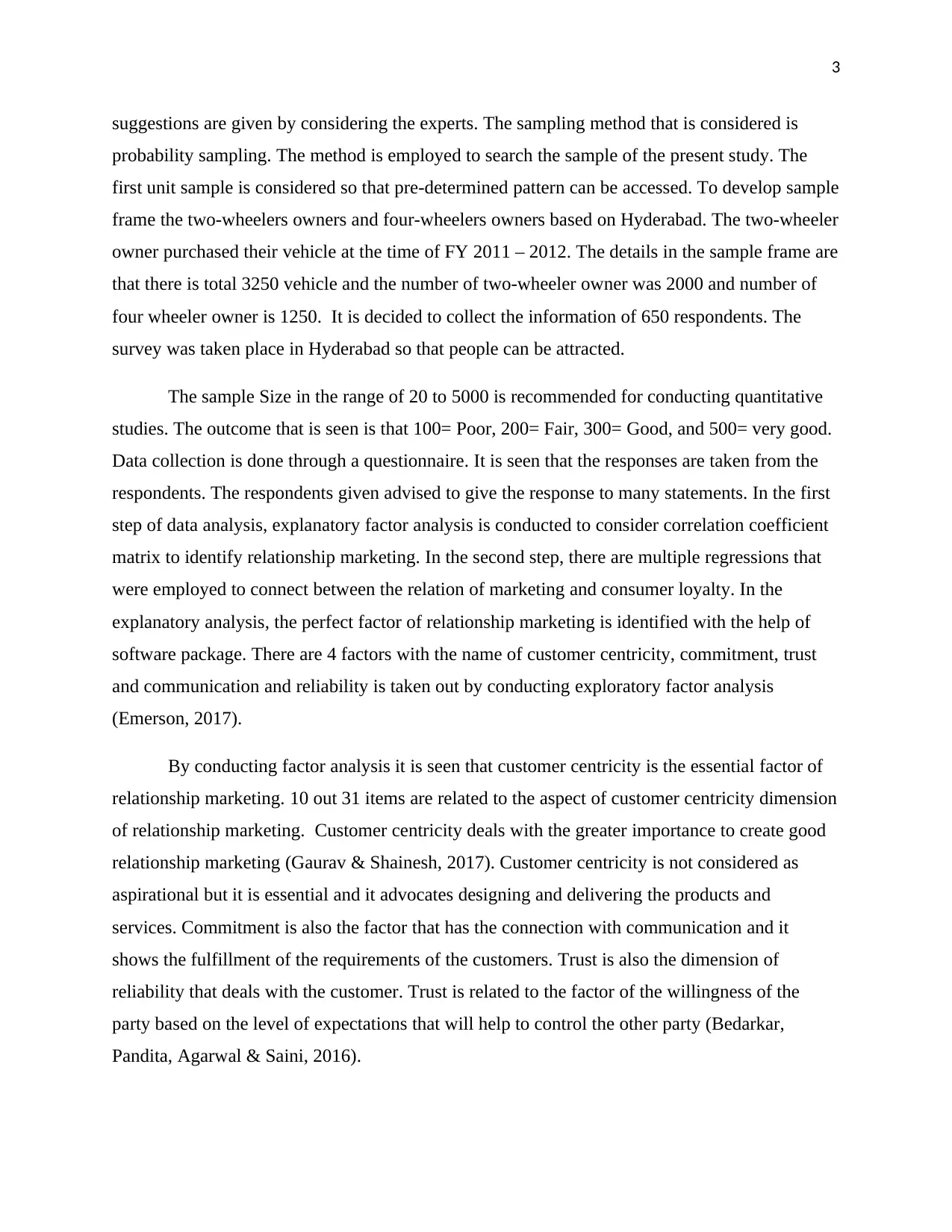
3
suggestions are given by considering the experts. The sampling method that is considered is
probability sampling. The method is employed to search the sample of the present study. The
first unit sample is considered so that pre-determined pattern can be accessed. To develop sample
frame the two-wheelers owners and four-wheelers owners based on Hyderabad. The two-wheeler
owner purchased their vehicle at the time of FY 2011 – 2012. The details in the sample frame are
that there is total 3250 vehicle and the number of two-wheeler owner was 2000 and number of
four wheeler owner is 1250. It is decided to collect the information of 650 respondents. The
survey was taken place in Hyderabad so that people can be attracted.
The sample Size in the range of 20 to 5000 is recommended for conducting quantitative
studies. The outcome that is seen is that 100= Poor, 200= Fair, 300= Good, and 500= very good.
Data collection is done through a questionnaire. It is seen that the responses are taken from the
respondents. The respondents given advised to give the response to many statements. In the first
step of data analysis, explanatory factor analysis is conducted to consider correlation coefficient
matrix to identify relationship marketing. In the second step, there are multiple regressions that
were employed to connect between the relation of marketing and consumer loyalty. In the
explanatory analysis, the perfect factor of relationship marketing is identified with the help of
software package. There are 4 factors with the name of customer centricity, commitment, trust
and communication and reliability is taken out by conducting exploratory factor analysis
(Emerson, 2017).
By conducting factor analysis it is seen that customer centricity is the essential factor of
relationship marketing. 10 out 31 items are related to the aspect of customer centricity dimension
of relationship marketing. Customer centricity deals with the greater importance to create good
relationship marketing (Gaurav & Shainesh, 2017). Customer centricity is not considered as
aspirational but it is essential and it advocates designing and delivering the products and
services. Commitment is also the factor that has the connection with communication and it
shows the fulfillment of the requirements of the customers. Trust is also the dimension of
reliability that deals with the customer. Trust is related to the factor of the willingness of the
party based on the level of expectations that will help to control the other party (Bedarkar,
Pandita, Agarwal & Saini, 2016).
suggestions are given by considering the experts. The sampling method that is considered is
probability sampling. The method is employed to search the sample of the present study. The
first unit sample is considered so that pre-determined pattern can be accessed. To develop sample
frame the two-wheelers owners and four-wheelers owners based on Hyderabad. The two-wheeler
owner purchased their vehicle at the time of FY 2011 – 2012. The details in the sample frame are
that there is total 3250 vehicle and the number of two-wheeler owner was 2000 and number of
four wheeler owner is 1250. It is decided to collect the information of 650 respondents. The
survey was taken place in Hyderabad so that people can be attracted.
The sample Size in the range of 20 to 5000 is recommended for conducting quantitative
studies. The outcome that is seen is that 100= Poor, 200= Fair, 300= Good, and 500= very good.
Data collection is done through a questionnaire. It is seen that the responses are taken from the
respondents. The respondents given advised to give the response to many statements. In the first
step of data analysis, explanatory factor analysis is conducted to consider correlation coefficient
matrix to identify relationship marketing. In the second step, there are multiple regressions that
were employed to connect between the relation of marketing and consumer loyalty. In the
explanatory analysis, the perfect factor of relationship marketing is identified with the help of
software package. There are 4 factors with the name of customer centricity, commitment, trust
and communication and reliability is taken out by conducting exploratory factor analysis
(Emerson, 2017).
By conducting factor analysis it is seen that customer centricity is the essential factor of
relationship marketing. 10 out 31 items are related to the aspect of customer centricity dimension
of relationship marketing. Customer centricity deals with the greater importance to create good
relationship marketing (Gaurav & Shainesh, 2017). Customer centricity is not considered as
aspirational but it is essential and it advocates designing and delivering the products and
services. Commitment is also the factor that has the connection with communication and it
shows the fulfillment of the requirements of the customers. Trust is also the dimension of
reliability that deals with the customer. Trust is related to the factor of the willingness of the
party based on the level of expectations that will help to control the other party (Bedarkar,
Pandita, Agarwal & Saini, 2016).
Paraphrase This Document
Need a fresh take? Get an instant paraphrase of this document with our AI Paraphraser
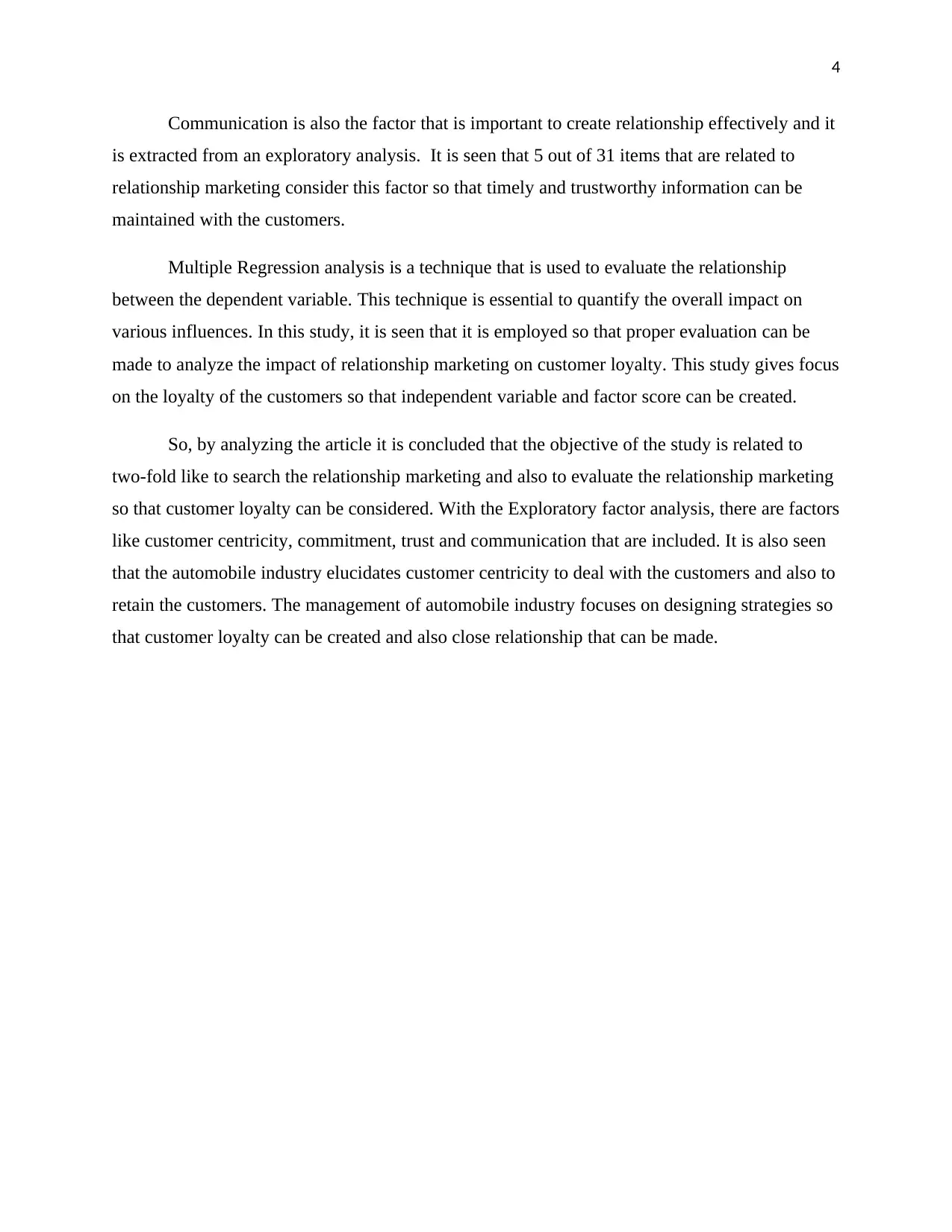
4
Communication is also the factor that is important to create relationship effectively and it
is extracted from an exploratory analysis. It is seen that 5 out of 31 items that are related to
relationship marketing consider this factor so that timely and trustworthy information can be
maintained with the customers.
Multiple Regression analysis is a technique that is used to evaluate the relationship
between the dependent variable. This technique is essential to quantify the overall impact on
various influences. In this study, it is seen that it is employed so that proper evaluation can be
made to analyze the impact of relationship marketing on customer loyalty. This study gives focus
on the loyalty of the customers so that independent variable and factor score can be created.
So, by analyzing the article it is concluded that the objective of the study is related to
two-fold like to search the relationship marketing and also to evaluate the relationship marketing
so that customer loyalty can be considered. With the Exploratory factor analysis, there are factors
like customer centricity, commitment, trust and communication that are included. It is also seen
that the automobile industry elucidates customer centricity to deal with the customers and also to
retain the customers. The management of automobile industry focuses on designing strategies so
that customer loyalty can be created and also close relationship that can be made.
Communication is also the factor that is important to create relationship effectively and it
is extracted from an exploratory analysis. It is seen that 5 out of 31 items that are related to
relationship marketing consider this factor so that timely and trustworthy information can be
maintained with the customers.
Multiple Regression analysis is a technique that is used to evaluate the relationship
between the dependent variable. This technique is essential to quantify the overall impact on
various influences. In this study, it is seen that it is employed so that proper evaluation can be
made to analyze the impact of relationship marketing on customer loyalty. This study gives focus
on the loyalty of the customers so that independent variable and factor score can be created.
So, by analyzing the article it is concluded that the objective of the study is related to
two-fold like to search the relationship marketing and also to evaluate the relationship marketing
so that customer loyalty can be considered. With the Exploratory factor analysis, there are factors
like customer centricity, commitment, trust and communication that are included. It is also seen
that the automobile industry elucidates customer centricity to deal with the customers and also to
retain the customers. The management of automobile industry focuses on designing strategies so
that customer loyalty can be created and also close relationship that can be made.
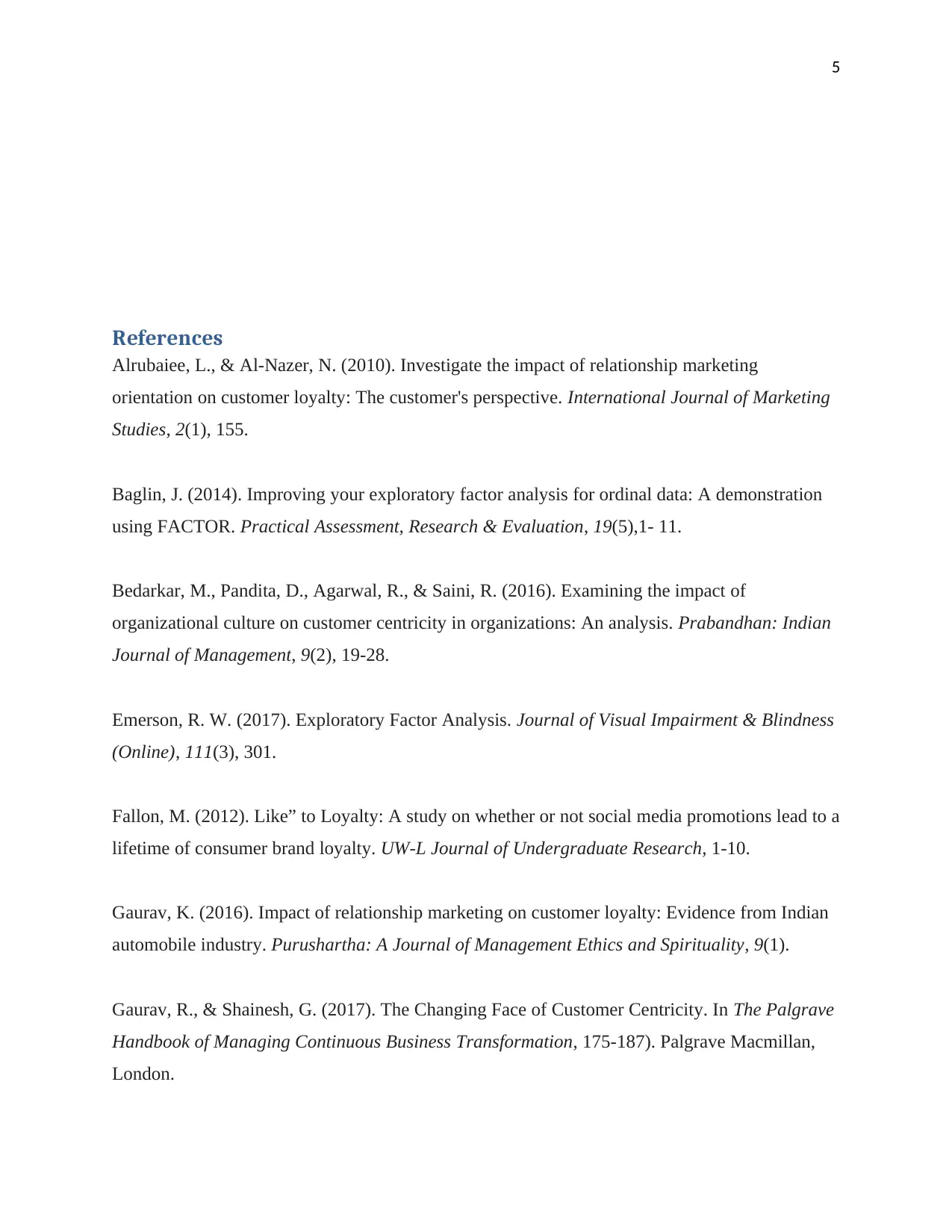
5
References
Alrubaiee, L., & Al-Nazer, N. (2010). Investigate the impact of relationship marketing
orientation on customer loyalty: The customer's perspective. International Journal of Marketing
Studies, 2(1), 155.
Baglin, J. (2014). Improving your exploratory factor analysis for ordinal data: A demonstration
using FACTOR. Practical Assessment, Research & Evaluation, 19(5),1- 11.
Bedarkar, M., Pandita, D., Agarwal, R., & Saini, R. (2016). Examining the impact of
organizational culture on customer centricity in organizations: An analysis. Prabandhan: Indian
Journal of Management, 9(2), 19-28.
Emerson, R. W. (2017). Exploratory Factor Analysis. Journal of Visual Impairment & Blindness
(Online), 111(3), 301.
Fallon, M. (2012). Like” to Loyalty: A study on whether or not social media promotions lead to a
lifetime of consumer brand loyalty. UW-L Journal of Undergraduate Research, 1-10.
Gaurav, K. (2016). Impact of relationship marketing on customer loyalty: Evidence from Indian
automobile industry. Purushartha: A Journal of Management Ethics and Spirituality, 9(1).
Gaurav, R., & Shainesh, G. (2017). The Changing Face of Customer Centricity. In The Palgrave
Handbook of Managing Continuous Business Transformation, 175-187). Palgrave Macmillan,
London.
References
Alrubaiee, L., & Al-Nazer, N. (2010). Investigate the impact of relationship marketing
orientation on customer loyalty: The customer's perspective. International Journal of Marketing
Studies, 2(1), 155.
Baglin, J. (2014). Improving your exploratory factor analysis for ordinal data: A demonstration
using FACTOR. Practical Assessment, Research & Evaluation, 19(5),1- 11.
Bedarkar, M., Pandita, D., Agarwal, R., & Saini, R. (2016). Examining the impact of
organizational culture on customer centricity in organizations: An analysis. Prabandhan: Indian
Journal of Management, 9(2), 19-28.
Emerson, R. W. (2017). Exploratory Factor Analysis. Journal of Visual Impairment & Blindness
(Online), 111(3), 301.
Fallon, M. (2012). Like” to Loyalty: A study on whether or not social media promotions lead to a
lifetime of consumer brand loyalty. UW-L Journal of Undergraduate Research, 1-10.
Gaurav, K. (2016). Impact of relationship marketing on customer loyalty: Evidence from Indian
automobile industry. Purushartha: A Journal of Management Ethics and Spirituality, 9(1).
Gaurav, R., & Shainesh, G. (2017). The Changing Face of Customer Centricity. In The Palgrave
Handbook of Managing Continuous Business Transformation, 175-187). Palgrave Macmillan,
London.
⊘ This is a preview!⊘
Do you want full access?
Subscribe today to unlock all pages.

Trusted by 1+ million students worldwide
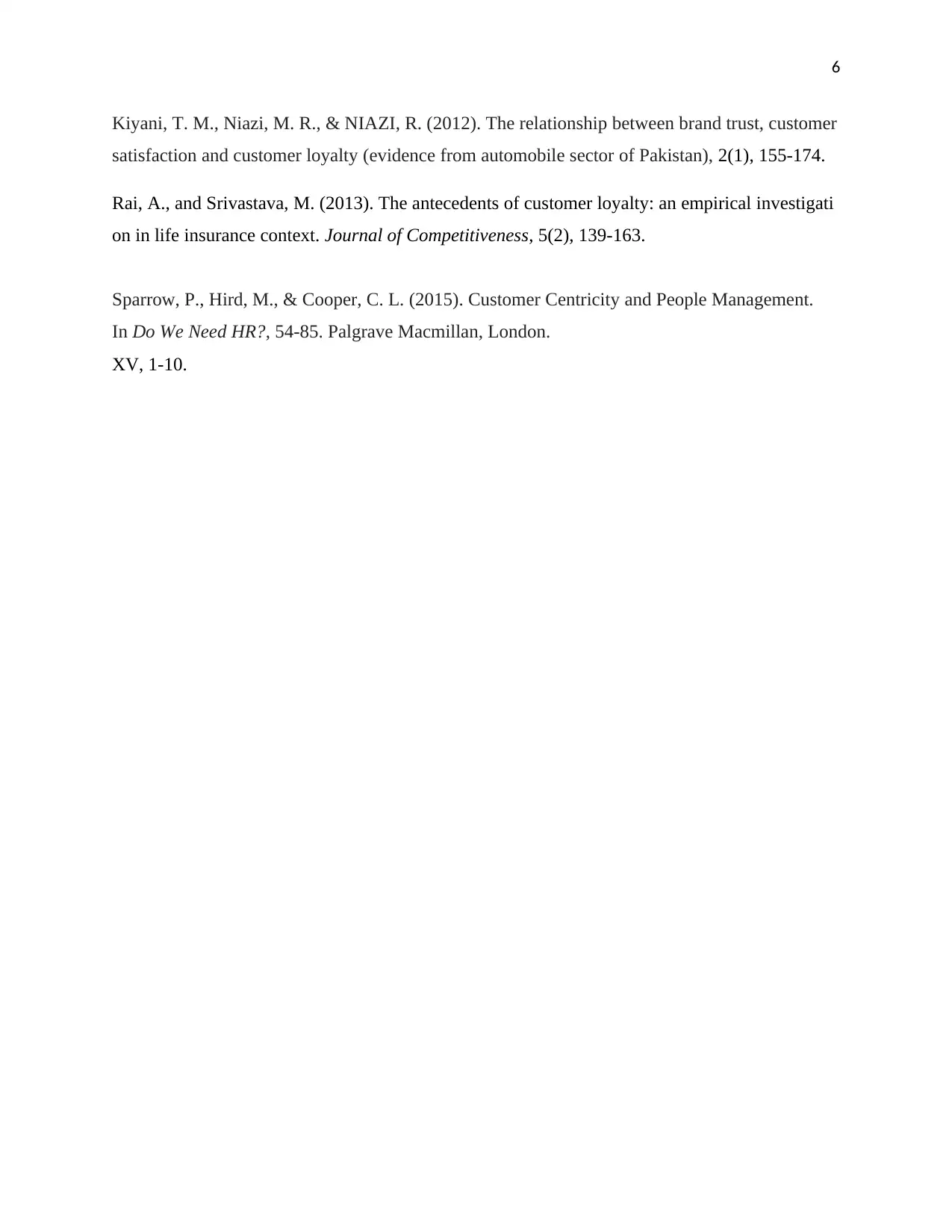
6
Kiyani, T. M., Niazi, M. R., & NIAZI, R. (2012). The relationship between brand trust, customer
satisfaction and customer loyalty (evidence from automobile sector of Pakistan), 2(1), 155-174.
Rai, A., and Srivastava, M. (2013). The antecedents of customer loyalty: an empirical investigati
on in life insurance context. Journal of Competitiveness, 5(2), 139-163.
Sparrow, P., Hird, M., & Cooper, C. L. (2015). Customer Centricity and People Management.
In Do We Need HR?, 54-85. Palgrave Macmillan, London.
XV, 1-10.
Kiyani, T. M., Niazi, M. R., & NIAZI, R. (2012). The relationship between brand trust, customer
satisfaction and customer loyalty (evidence from automobile sector of Pakistan), 2(1), 155-174.
Rai, A., and Srivastava, M. (2013). The antecedents of customer loyalty: an empirical investigati
on in life insurance context. Journal of Competitiveness, 5(2), 139-163.
Sparrow, P., Hird, M., & Cooper, C. L. (2015). Customer Centricity and People Management.
In Do We Need HR?, 54-85. Palgrave Macmillan, London.
XV, 1-10.
1 out of 7
Related Documents
Your All-in-One AI-Powered Toolkit for Academic Success.
+13062052269
info@desklib.com
Available 24*7 on WhatsApp / Email
![[object Object]](/_next/static/media/star-bottom.7253800d.svg)
Unlock your academic potential
Copyright © 2020–2025 A2Z Services. All Rights Reserved. Developed and managed by ZUCOL.





